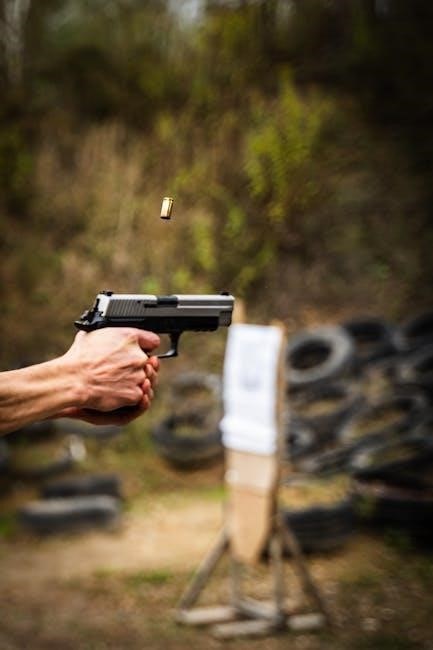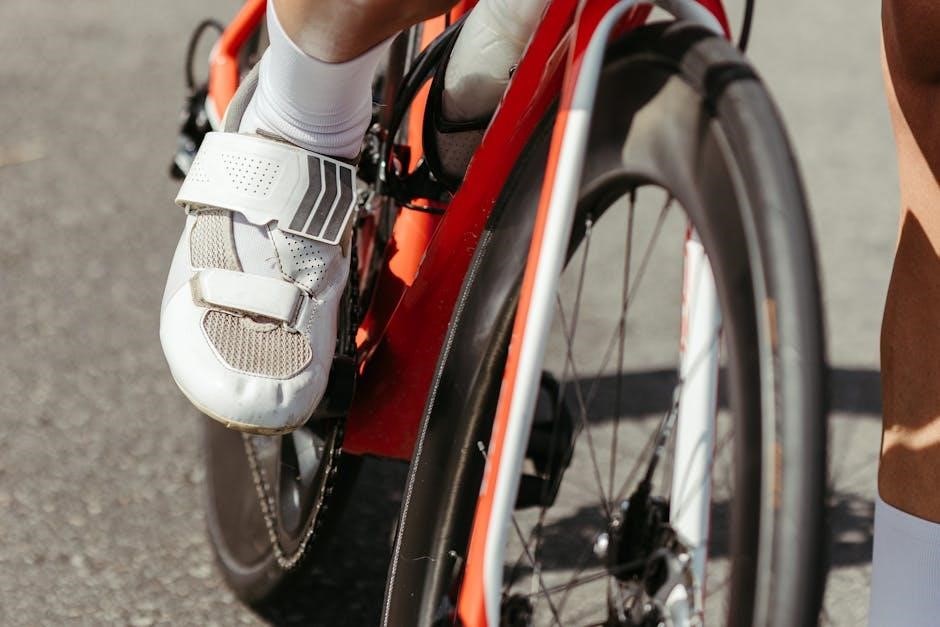Elbow range of motion exercises are essential for maintaining joint mobility, recovering from injuries, and enhancing daily functionality. These exercises improve flexion, extension, pronation, and supination, crucial for overall elbow health.
1.1 Overview of Elbow Range of Motion
Elbow range of motion refers to the extent of movement possible in the elbow joint, including flexion (bending) and extension (straightening), as well as pronation (palm-down rotation) and supination (palm-up rotation). The normal range for flexion/extension is typically 0 to 150 degrees, while pronation/supination ranges from 80 to 90 degrees. These movements are essential for daily activities, sports, and maintaining functional independence. Understanding and maintaining optimal elbow range of motion is crucial for preventing injuries, recovering from surgeries or injuries, and enhancing overall joint health. Regular exercises and stretches can help preserve or restore these movements.
1.2 Importance of Maintaining Elbow Mobility
Maintaining elbow mobility is vital for performing everyday tasks and preventing long-term joint stiffness. Reduced range of motion can hinder activities like reaching, lifting, and gripping, impacting quality of life. Elbow mobility also plays a key role in athletic performance, as limited motion can increase injury risk. Regular exercises help preserve flexibility, reduce pain, and promote recovery from conditions like tennis elbow or tendonitis. By prioritizing elbow mobility, individuals can maintain functional independence and overall joint health, ensuring optimal movement for years to come.

Types of Elbow Range of Motion Exercises
Elbow range of motion exercises include passive, active-assisted, and active movements, each catering to different recovery needs and mobility goals to enhance joint flexibility and strength.
2.1 Passive Range of Motion Exercises
Passive range of motion exercises involve an external force, such as a therapist or assistant, moving the elbow without the patient’s muscle activation. These exercises are beneficial for individuals with limited mobility or strength, as they help maintain joint flexibility and prevent stiffness. During passive exercises, the elbow is gently moved through its full range, including flexion, extension, pronation, and supination. Regular practice can improve joint lubrication and reduce the risk of contractures. These exercises are often used in the early stages of rehabilitation or for patients with severe injuries or chronic conditions.
2.2 Active-Assisted Range of Motion Exercises
Active-assisted range of motion exercises combine partial patient effort with external assistance, such as from a therapist or the opposite arm. These exercises are ideal for individuals with some strength but limited mobility. The patient initiates movement while the assistant provides support, enhancing control and reducing strain. This method promotes gradual strength recovery and mobility improvement. Examples include using the unaffected arm to assist the injured elbow during flexion or extension. Regular practice can accelerate recovery, especially in cases like tennis elbow or post-surgical rehabilitation, by fostering independence and reducing reliance on passive techniques.
2.3 Active Range of Motion Exercises
Active range of motion exercises involve movements performed entirely by the patient using their own muscle power, without external assistance. These exercises focus on improving elbow flexion, extension, pronation, and supination. By engaging the biceps, triceps, and forearm muscles, active exercises enhance strength, mobility, and joint stability. They are particularly beneficial for patients with mild to moderate elbow restrictions or those recovering from injuries like tendonitis. Regular practice of these exercises can restore functional movement, reduce stiffness, and prevent future injuries, making them a cornerstone of elbow rehabilitation programs for athletes and individuals with repetitive strain injuries.
2.4 Advanced Range of Motion Exercises
Advanced range of motion exercises are designed for individuals who have regained baseline elbow mobility and seek to enhance functional performance. These exercises incorporate dynamic movements, resistance training, and multi-planar activities to improve joint stability and muscular endurance. Techniques such as weighted pronation-supination, resistance band flexion-extension, and functional tasks like tossing or gripping are commonly used. Advanced exercises are particularly effective for athletes or those with demanding occupational requirements, helping to restore high-level functionality, prevent re-injury, and optimize elbow performance in complex or overhead activities.

Muscle Anatomy and Elbow Movement
The elbow joint is powered by the biceps and triceps, which control flexion and extension. Forearm muscles enable pronation and supination, essential for wrist and hand coordination.
3.1 Biceps and Triceps: Key Muscles for Elbow Flexion and Extension
The biceps brachii and triceps brachii are central to elbow movement. The biceps facilitates flexion, bending the elbow, while the triceps enables extension, straightening it. These muscles work synergistically, ensuring smooth motion. Strengthening and stretching these muscles through exercises like curls and tricep dips improves joint stability and range of motion. Weakness or imbalances can lead to injuries, such as tennis elbow or tendonitis, emphasizing the importance of targeted exercises in maintaining elbow health and functionality.
3.2 Forearm Muscles: Role in Pronation and Supination
The forearm muscles, including the pronator teres and supinator, are vital for pronation (palm-down rotation) and supination (palm-up rotation). These movements are essential for tasks like turning door handles or using tools. Strengthening these muscles through exercises like forearm rotations and grip strengthening enhances elbow functionality. Weakness in these muscles can limit range of motion and lead to injuries. Proper exercises, combined with stretches, help maintain flexibility and prevent conditions like tennis elbow. Regular practice ensures optimal forearm muscle function, supporting overall elbow mobility and reducing injury risk. Consistency is key to maintaining healthy pronation and supination abilities.

Benefits of Elbow Range of Motion Exercises
Regular elbow range of motion exercises enhance joint mobility, reduce stiffness, and alleviate pain. They improve flexibility, strengthen surrounding muscles, and prevent injuries, promoting overall elbow health and functionality.
4;1 Improving Joint Mobility and Flexibility
Elbow range of motion exercises significantly enhance joint mobility and flexibility by targeting the muscles and ligaments surrounding the elbow. Regular practice ensures that the joint maintains its natural range, allowing for smoother movements during daily activities and sports. Improved flexibility reduces the risk of stiffness and injury, while also promoting better blood circulation to the area. Over time, consistent exercise helps maintain the elbow’s functional range, enabling individuals to perform tasks with greater ease and efficiency. This is particularly beneficial for athletes and those with repetitive motion jobs.
4.2 Relieving Pain and Reducing Stiffness
Elbow range of motion exercises are highly effective in alleviating pain and reducing stiffness, particularly for individuals with conditions like tennis elbow or tendonitis. Gentle stretching and mobilization techniques help break down adhesions and improve joint lubrication, minimizing discomfort. Passive and active-assisted exercises are especially beneficial for those with limited mobility, as they promote healing without overexertion; Consistent practice can significantly reduce inflammation and restore comfort, allowing for a faster return to normal activities. These exercises are often recommended in rehabilitation programs to enhance recovery and maintain joint health.
4.3 Preventing Injuries and Enhancing Athletic Performance
Elbow range of motion exercises play a crucial role in injury prevention and improving athletic performance. By enhancing flexibility and strength, these exercises reduce the risk of strains and overuse injuries common in sports. For athletes, particularly those in baseball, tennis, and golf, incorporating dynamic stretches and strengthening routines can improve joint stability and endurance. Proper execution of movements like flexion and extension ensures optimal mechanics, minimizing the risk of damage. Regular practice also boosts power and precision, giving athletes a competitive edge while safeguarding against potential harm.

Common Elbow Injuries and Their Impact on Range of Motion
Common elbow injuries like tennis elbow, tendonitis, and bursitis often restrict range of motion, causing pain and stiffness. These conditions can limit flexion, extension, and joint mobility, requiring targeted exercises for recovery and restoring functionality.
5.1 Tennis Elbow (Lateral Epicondylitis)
Tennis elbow, or lateral epicondylitis, is a common injury causing pain on the outer elbow, often due to repetitive forearm and wrist movements. It frequently affects athletes, particularly tennis players, with studies showing it occurs in approximately 50% of them. This condition leads to stiffness and reduced range of motion, impacting activities like gripping or lifting. Passive and active-assisted exercises are crucial for recovery, aiming to restore flexion, extension, and pronation/supination. Early intervention with targeted stretches and strengthening exercises can improve functionality and prevent chronic pain, making it essential for athletes to incorporate these into their routines to maintain elbow mobility and overall performance.
5.2 Elbow Tendonitis and Bursitis
Elbow tendonitis and bursitis are inflammatory conditions affecting the tendons and bursae around the joint. Tendonitis involves swelling of the tendons, while bursitis inflames the fluid-filled sacs cushioning the joint. Both conditions cause pain, stiffness, and limited mobility, particularly during flexion and extension. Passive range of motion exercises can help maintain joint functionality without exacerbating inflammation. Hydrotherapy and gentle stretching are recommended to improve elbow flexibility and reduce discomfort. Early intervention through these exercises can prevent chronic issues and restore normal range of motion, ensuring continued participation in daily activities and sports.
5.3 Elbow Contracture and Stiffness
Elbow contracture and stiffness occur when the joint’s range of motion is significantly reduced due to scar tissue, inflammation, or prolonged immobilization. This condition limits both flexion and extension, making daily activities challenging. Early intervention, such as passive range of motion exercises and hydrotherapy, can help restore functionality. Severe cases may require surgical intervention to release contracted tissues. Gentle stretching and progressive exercises are crucial for improving mobility and preventing further stiffness. Addressing contracture early enhances recovery outcomes and reduces the risk of long-term limitations in elbow movement and functionality.

Measuring Elbow Range of Motion
Elbow range of motion is typically measured using a goniometer, assessing flexion, extension, pronation, and supination. Normal range is 0-150 degrees for flexion/extension and 80-90 degrees for pronation/supination.
6.1 Using a Goniometer for Accurate Measurement
A goniometer is a reliable tool for measuring elbow range of motion, providing precise data on flexion, extension, pronation, and supination. The device consists of a fulcrum, stationary arm, and moving arm. To measure, align the goniometer’s axis with the lateral epicondyle of the elbow. The stationary arm is placed along the upper arm, while the moving arm aligns with the forearm. This setup allows accurate assessment of joint mobility. Normal elbow range of motion typically ranges from 0 to 150 degrees for flexion/extension and 80 to 90 degrees for pronation/supination. Accurate measurement is crucial for tracking progress and ensuring proper rehabilitation.
6.2 Understanding Normal vs. Restricted Range of Motion
The normal elbow range of motion includes 0 to 150 degrees for flexion/extension and 80 to 90 degrees for pronation/supination. Restricted range of motion occurs when these limits are reduced, often due to injuries, stiffness, or conditions like tendonitis or contractures. Identifying these limitations is crucial for diagnosing mobility issues. Restricted motion can hinder daily activities and athletic performance. Exercises tailored to improve flexibility and strength help restore normal range of motion, enhancing joint functionality and overall well-being. Accurate assessment of these ranges ensures effective rehabilitation and injury prevention strategies.

Creating a Daily Routine for Elbow Range of Motion
A daily routine should include exercises like flexion, extension, pronation, and supination. Consistency is key for improving mobility and preventing stiffness, as outlined in detailed PDF guides.
7.1 Frequency and Duration of Exercises
Elbow range of motion exercises should be performed 2-3 times daily, with each session lasting 10-15 minutes. Start with passive exercises, holding each stretch for 20-30 seconds, and gradually incorporate active movements. Aim for 3-5 repetitions per exercise to maximize mobility. Consistency is crucial for improving joint flexibility and reducing stiffness. Over time, increase the intensity by adding resistance or progressing to active-assisted exercises. Always warm up before starting and cool down afterward to prevent strain. Tailor your routine based on individual needs and consult a physical therapist for personalized guidance, especially during recovery from injuries or surgeries.
7.2 Proper Technique and Repetition
Proper technique is the foundation of effective elbow range of motion exercises. Begin with passive exercises, where an external force (e.g., a therapist or unaffected arm) guides the movement. Gradually transition to active-assisted exercises, combining partial effort with assistance. For active exercises, use only the muscles around the elbow joint. Perform 8-12 repetitions per set, ensuring smooth, controlled movements. Avoid bouncing or forcing beyond a comfortable range. Use a goniometer to measure progress accurately. Consistency and precision are key to improving mobility without risking injury. Over time, increase repetitions or resistance as strength and flexibility improve.
7.3 Progressing from Passive to Active Movements
Progression from passive to active elbow movements ensures a safe and effective rehabilitation process. Begin with passive exercises, where an external force (e.g., a therapist or unaffected arm) moves the elbow through its range. As strength and control improve, transition to active-assisted exercises, combining personal effort with assistance. Finally, advance to full active movements, relying solely on the elbow’s muscles. This structured progression minimizes strain and prevents overexertion, promoting gradual strength and flexibility gains. Regular assessment with a goniometer helps track improvement and guide the transition between phases effectively.
Role of Physical Therapy in Elbow Rehabilitation
Physical therapy plays a crucial role in elbow rehabilitation by providing personalized exercise plans, improving joint mobility, and enhancing strength. Certified therapists utilize techniques like hydrotherapy and goniometry to ensure optimal recovery and restore function.
8.1 Certified Therapists and Customized Exercise Plans
Certified physical therapists specialize in designing personalized exercise plans tailored to individual elbow conditions. They assess joint mobility, strength, and pain levels to create targeted programs. These plans often include passive, active-assisted, and active range of motion exercises, along with strengthening routines. Therapists use tools like goniometers to measure progress and adjust exercises accordingly. Customized plans ensure optimal recovery, improving flexibility and reducing stiffness. They also focus on preventing future injuries by enhancing joint stability and muscle balance. Regular follow-ups allow therapists to modify exercises as patients progress, ensuring a comprehensive approach to elbow rehabilitation and functional restoration.
8;2 Hydrotherapy and Its Benefits for Elbow Mobility
Hydrotherapy offers a gentle, low-impact environment to enhance elbow mobility and reduce stiffness. Water’s buoyancy reduces joint stress, allowing for pain-free movement. Studies show improved range of motion in conditions like elbow dysplasia. Hydrotherapy sessions can include controlled exercises targeting flexion, extension, pronation, and supination. The soothing effects of water also aid in muscle relaxation, promoting faster recovery. Regular hydrotherapy sessions complement traditional exercises, offering a holistic approach to restoring elbow function and improving overall joint health, especially for athletes and individuals with chronic elbow conditions.
Preventing Elbow Injuries Through Exercise
Targeted exercises improve elbow flexibility and strength, reducing injury risk. Warm-ups and strengthening routines enhance joint stability, crucial for athletes and individuals with repetitive elbow strain.
9.1 Warm-Up Exercises for Elbow Flexibility
Warm-up exercises are crucial for preparing the elbow joint for physical activity, reducing stiffness, and improving circulation. Gentle circular motions, wrist extensions, and forearm rotations are effective. These exercises enhance flexibility and mobility, minimizing injury risk. Incorporating stretches like the tricep stretch and elbow bends can improve joint function. Regular warm-ups ensure the elbow is ready for more intense movements, preventing strain and maintaining optimal range of motion. Consistency in these routines is key for long-term elbow health and performance.
9.2 Strengthening Exercises for Elbow Stability
Strengthening exercises are vital for enhancing elbow stability and preventing injuries. Wrist curls and extensions using light weights or resistance bands can improve forearm and bicep strength. Isometric exercises, such as holding weights with the elbow bent, also build muscle endurance. Strengthening the surrounding muscles helps stabilize the joint, reducing the risk of strains or sprains. These exercises are particularly beneficial for athletes and individuals with repetitive elbow use, promoting long-term joint health and resilience. Consistent practice ensures optimal elbow function and supports overall arm mobility.

When to Seek Professional Help
Seek professional help immediately if you experience severe elbow pain, swelling, or limited mobility. Persistent pain lasting over a week or inability to perform daily activities warrants medical attention. Consulting a doctor or physical therapist is crucial for diagnosing conditions like tendonitis, fractures, or ligament tears. Early intervention prevents further damage and promotes proper healing. Delaying treatment can lead to chronic issues or reduced range of motion.
10.1 Signs of Severe Elbow Injury or Chronic Pain
Severe elbow injuries often present with intense pain, swelling, or visible deformity. Chronic pain may manifest as persistent ache, limited mobility, or stiffness. Numbness or tingling in the arm or hand can indicate nerve involvement. Difficulty bending or straightening the elbow, along with redness or warmth around the joint, may signal infection or inflammation. If you experience a sudden inability to move the elbow or hear a popping sound, seek immediate medical attention, as these could be signs of a fracture, ligament tear, or tendon rupture.
10.2 Importance of Early Intervention
Early intervention is crucial for addressing elbow injuries or chronic pain to prevent long-term damage and improve recovery outcomes. Delaying treatment can lead to chronic conditions, reduced mobility, and prolonged rehabilitation. Seeking professional help at the first signs of severe injury or persistent pain ensures timely diagnosis and effective treatment plans. Early intervention can significantly enhance the effectiveness of therapies, including range of motion exercises, and reduce the risk of complications. Prompt action also minimizes the likelihood of invasive treatments, allowing for a faster return to normal activities and maintaining overall elbow health.

Sports-Specific Elbow Range of Motion Exercises
Sports-specific elbow exercises are tailored for athletes, addressing movements unique to their activities. These exercises help prevent injuries, enhance performance, and maintain joint flexibility, crucial for optimal functionality.
11.1 Exercises for Baseball Pitchers and Overhead Athletes
Baseball pitchers and overhead athletes often experience elbow strain due to repetitive throwing motions, leading to injuries like medial epicondylitis or UCL strains. Specific exercises focus on improving flexion, extension, and rotational movements. Passive stretching, such as weighted ball drills, enhances flexibility, while active exercises like wrist flexor stretches and tricep stretches reduce muscle tension. Dynamic exercises, including arm circles and wall slides, promote joint mobility. These routines are designed to prevent injury, maintain optimal range of motion, and ensure peak performance during games and training.
11.2 Tailored Routines for Tennis and Golf Players
Tennis and golf players benefit from specialized elbow range of motion exercises to address sport-specific demands. For tennis players, exercises focus on reducing lateral epicondylitis risk by improving wrist and forearm flexibility. Passive stretches, such as wrist flexor and extensor stretches, are essential. Golfers require routines that enhance elbow mobility and strength for a consistent swing. Dynamic exercises like arm circles and resistance band work improve joint stability. These tailored routines help prevent injuries, maintain performance, and ensure proper mechanics, reducing the risk of overuse injuries common in these sports.

Elbow Range of Motion Exercises PDF Resources
Elbow range of motion exercises PDF guides provide detailed routines, illustrations, and progress tracking tools. They include structured plans for improving flexion, extension, and forearm mobility, ensuring safe and effective practice.
12.1 Overview of Available PDF Guides
Elbow range of motion exercise PDF guides offer comprehensive workout plans tailored for various needs, from rehabilitation to enhancing athletic performance. These guides typically include step-by-step instructions, visual aids, and customizable routines. They often cover exercises like passive and active range of motion, stretching, and strengthening; Some PDFs are designed for specific injuries, such as tennis elbow or tendonitis, while others focus on improving mobility for daily activities. Many guides are created by physical therapists and include measurable goals and tracking sheets for progress monitoring, making them a valuable resource for anyone seeking to improve elbow functionality and reduce pain.
12.2 Key Features to Look for in a PDF Guide
When selecting a PDF guide for elbow range of motion exercises, look for clear instructions, detailed diagrams, and customizable routines. Ensure the guide covers both passive and active exercises, addressing flexibility, strength, and injury recovery. It should include progress tracking tools and measurable goals. Guides authored by physical therapists or medical professionals are ideal, as they provide evidence-based methods. Additionally, check for adaptability to different fitness levels and specific conditions like tennis elbow or tendonitis. A well-structured PDF guide will enhance your ability to safely and effectively improve elbow mobility and overall joint health.
Elbow range of motion exercises are crucial for enhancing mobility, managing pain, and preventing injuries. Consistent practice, guided by comprehensive PDF resources, ensures optimal elbow health and functionality.
13.1 Recap of the Importance of Elbow Range of Motion Exercises
Elbow range of motion exercises are vital for maintaining joint mobility, recovering from injuries, and enhancing daily functionality. They improve flexibility, strength, and reduce stiffness, crucial for preventing chronic pain and injuries. Regular practice ensures optimal elbow health, enabling seamless performance of everyday tasks and athletic activities. These exercises, often detailed in comprehensive PDF guides, offer structured routines tailored to individual needs, promoting long-term joint stability and overall well-being. Consistency is key to achieving and maintaining full elbow mobility, making these exercises an essential part of any rehabilitation or preventive care plan.
13.2 Encouragement for Consistent Practice
Consistency is key to maximizing the benefits of elbow range of motion exercises. Regular practice strengthens muscles, improves joint flexibility, and prevents stiffness. Over time, these exercises empower individuals to perform daily tasks and athletic activities with ease. PDF guides offer structured routines, making it easier to stay committed. Remember, every repetition is an investment in long-term elbow health. By prioritizing these exercises, you take a proactive approach to injury prevention and recovery. Stay dedicated, and watch your mobility and strength improve progressively. Elbow health is a lifelong journey, and consistent practice ensures lasting results.



